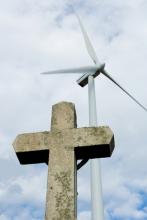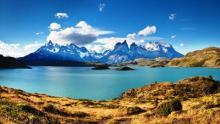Environmental Stewardship
Unprecedented levels of air pollution effectively closed the city of Harbin in northern China earlier this week. Smog limited visibility in some places up to 30 feet, and measurements of fine particulate pollution skyrocketed a record 40 times higher than the worse safe level set by the World Health Organization, according to the Washington Post.
In the city of 11 million, schools, public bus routes, and the airport were all forced to suspend activities given the unsafe conditions. Hospital admittances of patients with respiratory problems soared an additional 30 percent.
The cause, according to local Chinese news outlets, was the first day of the city’s heating being turned on before winter. China’s air quality has consistently been found to be harmful in the recent decades of the country’s rapid industrial development.

There’s a debate happening on The Christian Post, and we’re hearing more and more evangelical voices expressing concern over climate change.
Over the summer, talk radio pundit Rush Limbaugh made a comment about people believing in God and manmade global warming: he said it was “intellectually impossible.” It is not, of course, impossible to have faith in God and to agree with 97 percent of scientists that we are harming God’s creation with climate change. And in response to Rush’s comments, Sojourners sent Mr. Limbaugh a letter signed by more than 9,000 people of faith asking him to correct the record (which he has not yet done).
But Rush Limbaugh’s comments also sparked a conversation on the popular evangelical website, The Christian Post. Two prominent climate scientists who are also evangelical Christians, Dr. Katharine Hayhoe and Dr. Tom Ackerman, responded to Rush in an open letter on site. They told Rush that, contrary to his assumptions, they are compelled to work in their field by both their faith in God and their expertise in atmospheric science.

Occurrences of oil spills in several states have garnered little media attention in the last few years. In some cases, prompt reports are recorded, yet in others, days have gone by before the authorities are alerted and the spill becomes public knowledge.
The most recent episode happened Oct. 15, in Port of Long Beach, Calif. Upon discovery of an oil leak, Exxon Mobil announced that it was temporarily suspending operations of its pipeline system. The pipeline, which connects to the company’s refinery in Torrance, carries up to 155,000 barrels of oil per day. Exxon filed documents with the California Emergency Management Agency that claimed the leak did not affect waterways, although the company was ordered to pay a $236 million fine for contaminating groundwater in New Hampshire this past April.
Another spill was initially discovered on Sept. 29 by North Dakota farmer Steve Jensen, the Associated Press reported. While harvesting wheat, Jensen discovered the leak in his field “spewing and bubbling 6 inches high.” The rupture was a break in Tesoro Corporation’s underground pipeline. While it remains unconfirmed, early evidence cites that corrosion on the 20-year-old pipeline is the cause of rupture. At least 20,600 barrels of oil flooded the 7-acre spill zone, equal to about 7 football fields.
The delay in making public North Dakota’s oil spill proves as worrisome as the spill itself. It took 11 days after the spill’s discovery for it to become public knowledge. Officials claim they were not aware how extensive the spill was, but critics point to the state’s financial benefits in the recent gas and oil boom as reason for the authorities’ hesitancy in coming down on oil companies. But economic incentives shouldn’t diminish the serious need to weigh environmental risks and costs.
The cases begin to pile up.

Is access to clean water for public use a human right? According to Luis Infanti, the Roman Catholic bishop of Aysen in Chile, the answer is yes. This week marks the opening of Chile’s “First Cabildo for Water,” a meeting organized by the Coalition for the Defense of Water and Life, comprising civil society and religious groups.
People from all over Chile are attending and bringing water samples taken from lakes, streams, and rivers in their communities to be blessed by Bishop Infanti. “Water has often been captured, kidnapped and commodified,” said Infanti, according to Agenzia Fides, “but we know that it must give life and reach all our brothers and sisters, flow in abundance and not be anyone’s privilege.”

During the government shutdown, some cuts have caught the public’s attention more than others. And some people are rejoicing over the cuts faced by the Environmental Protection Agency and other environmental agencies. But the shutdown of our environmental programs is affecting people’s lives in ways that might surprise you.
1. National Parks closures are more than an inconvenience
In some National Parks across the country, employees are stranded. Employees who live on park grounds, like park rangers and concession workers, have no work or pay, and because the parks are closed, they’re not even allowed to take solace in the trails that surround them. And in at least one case, they don’t have any food. About 2,200 employees – 1,800 of them concession workers – are stranded in Grand Canyon National Park. A local food bank has started making deliveries, because those people are going hungry and without pay.

At an interfaith summer camp in northern New Jersey, two dozen children explored a swamp to learn how creatures depend on safe water.
In Southern California, a Unitarian Universalist congregation installed a dry well so water from its church rooftops drains into underground pipes to replenish the water table.
In Vermont, members of a Lutheran church removed cars and appliances that had been dumped in a nearby stream and restored its banks with local willows and oaks.
Across the country, water has become more than a ritual element used in Christian baptismal rites or in Jewish and Muslim cleansing ceremonies. It has become a focus for worshippers seeking to go beyond water’s ritual symbolism and think more deeply about their relationship to this life-giving resource.
OFFICER MARIO normally worked for Homeland Security. On this Friday night he’d been seconded to the Washington, D.C. Metro police, who had their hands full. Not only did they have the usual “drunk and disorderlies,” but now 54 people who looked like card-carrying members of the AARP were filling up their holding cells. Officer Mario, of retirement age himself, was feeling fortunate. He’d been assigned to the women’s side.
“Ladies, ladies, ladies!” Mario said, sauntering in with a mischievous smile. “This must be my lucky night.”
The evening before, we’d all been at St. Stephen and the Incarnation Episcopal Church running role plays on how to “flash mob” the corporate headquarters of Environmental Resources Management (ERM), the firm hired by the U.S. State Department to provide an environmental impact statement on the Keystone XL pipeline. To the disbelief and concern of climate scientists, ERM claimed that TransCanada’s Keystone pipeline would not significantly contribute to climate change. ERM was suspected of “misleading disclosures” regarding conflict of interest and material gain from the pipeline’s completion.
Our white-haired mob of mostly grandparents converged on ERM headquarters at noon to shine a light on such shady dealings. While six silver foxes blocked the elevators by chaining their arms together inside a PVC pipe, I watched two D.C. police lift Steve, age 70, and toss him into the crowd behind me. I knew this nonviolent civil disobedience wasn’t going as planned.

Texas high school biology textbooks battles are once again in progress in Austin, with lines drawn between those who want textbook material based only on established mainstream science and those who are anti-science. As an evangelical Christian and a botany professor at Hardin-Simmons University in Abilene, Texas, I am all too familiar with the battle for scientific authenticity in our state’s textbooks.
The Texas State Board of Education (SBOE) wields an enormous influence over which textbooks are adopted by school districts in Texas. And because the Texas market for public school textbooks is one of the country’s largest, publishers use the curriculum and content from Texas books in those they print for the rest of the nation. For this reason, what happens in Texas doesn’t stay in Texas. This is why it is so important that we ensure that publishers produce books based on mainstream science.

I just completed my first Climate Ride, journeying 300 miles by bicycle over five days with 200 other climate activists. Climate Ride began five years ago, and the riders raise money for organizations that work on sustainability and climate change. They’re also a way to spread the word about the growing and increasingly determined climate movement. For those of us who take part – by now, thousands of us have – the rides have a deep and lasting impact.
These are my reflections from the last day of the ride; you can read reflections on the first four days of the Climate Ride here.
THE ANACOSTIA RIVER is a river of contrasts. Often called “the nation’s forgotten river,” it flows for eight-and-a-half miles through some of the richest and poorest communities in and around D.C., through residential and industrial zones, through marshes and military installations. In fact, the federal government owns so much land in the watershed that when all those federal toilets flush during a heavy rain, they drain directly into the river.
The Anacostia River watershed is home to more than 800,000 people, 43 species of fish, and nearly 200 species of birds—including our nation’s symbol, the bald eagle, and the majestic great blue heron. Yet the trash in the river is so deep and wide at times that you’re just as likely to see a heron walking across a flotilla of trash rather than flying over the water.
As the Anacostia Riverkeeper—part of the Waterkeeper Alliance movement to protect local waterways—it was my job for three years to be the eyes, ears, and voice of its watershed. Of the nearly 200 waterkeepers worldwide, I was the only riverkeeper who was also a minister. I was called “Rev. Riverkeeper.”
The antiquated sewer system that pumps more than 2 billion gallons of raw sewage, mixed with polluted runoff, into the river each year is not just a shame, it’s a sin. African-American churches along the Anacostia used to baptize their members in the river. Nowadays, the river wouldn’t wash away anyone’s sins. My goal as Rev. Riverkeeper was an Anacostia that was not only “fishable” and “swimmable”—as required by the Clean Water Act—but also “baptizable.”
As the Creation Care campaign associate at Sojourners, my job is to get people thinking about God’s call for us to care about the creation. Usually, I do that from behind a desk in Washington, D.C., but recently I got to do it from a boat out on the bayou in Louisiana, in a tiny community that has been hit by eight disasters in eight years (seven hurricanes and the Deepwater Horizon oil spill). I took 100 people out to the town of Jean Lafitte, less than an hour from New Orleans, to hear from people who live on the front lines of climate change.
One of the obstacles to igniting a passion about climate change is that it feels so abstract; it feels like a future problem, a global problem. But it’s really a here and now problem. We took folks out on the Louisiana bayou to meet with those who are living in the midst of climate change – people who don’t think of themselves as environmentalists, but who can bear witness to the impact that climate change and our use of dirty energy have had on their lives, personally.
The town of Jean Lafitte is an old and diverse town, a close-knit community where faith is important to many people, including the mayor. It’s a town that sounds a lot like the early Christian church. We were told that homelessness is not a problem there – if your neighbor loses her home, why wouldn’t you take her in? We were told that when the state government showed up two weeks after Hurricane Katrina, the town had recovered so quickly that the government thought the hurricane hadn’t hit them. This community comes together, and because it knows how to survive, it often gets forgotten by government responders and by oil companies like BP.

I always thought of climate change as something that affected developing countries. Through my work at World Renew, an international disaster response and community development organization, I am well acquainted with the devastating effects of changing growing seasons in Africa and environmental refugees in Bangladesh. I probably shouldn’t have been so surprised to learn that there are ecojustice issues here in the U.S. — but I was.
Last week I had the opportunity to tour the town of Jean Lafitte just outside New Orleans. Hosted by Sojourners, it was one of the “Go and See” options during the Christian Community Development Association conference.
Our tour began with a presentation by the Rev. Kristina Peterson and Mayor Tim Kerner at the Jean Lafitte National Historical Park and Preserve. There we learned that since the 1930s, Louisiana has lost a football field of wetlands every 38 minutes. At the current rate, the state will lose an area of wetlands the size of Rhode Island by 2050. According to Peterson, 36 percent of the wetland loss can be attributed to the activities of the oil and gas industry — in particular, the canals they carve out.

In my state of Minnesota, there are literally hundreds of faith-based green teams doing a variety of good works. We’ve collectively tackled solar panels and bike racks. We’ve individually been consuming less, doing energy audits of our homes, and taking action in our neighborhoods. It is important work. And yet when I talk to the lay leaders in these congregations, they report that enthusiasm has waned and that their groups have become stale. As one tired (and yet tireless) leader confided in me: “I don’t know what it is, Julia, but it’s like we are swimming in molasses.”
As the new executive director of Minnesota Interfaith Power & Light I am trying to pay attention. What is this feeling of stuck-ness? If it’s not working, what then is the special sauce that will help these tireless leaders to ignite their communities?
A few observations about humans:

This Wednesday on Capitol Hill, the House subcommittee on Energy and Power held a hearing to discuss the Obama administration’s climate change policies and activities. The policies in question were the president’s Climate Action Plan, announced this summer, which has three main pillars:
- cutting carbon emissions,
- leading international efforts to combat climate change, and
- preparing the United States for climate change impacts.
The Environmental Protection Agency Administrator Gina McCarthy and the Energy Secretary Ernest Moniz were present to answer questions about the president’s plan, which works with new and existing programs in both agencies to reduce our climate change pollution and increase our resilience to climate change. Some of the programs are required by a recent Supreme Court decision that labeled carbon dioxide a pollutant; others, as Moniz pointed out, would happen to carry the benefit of energy efficiency.
For some members of Congress, this is a problem because they do not wish to cede any ground to the executive. For others, it is a problem simply because they do not wish to do anything about climate change.

David vs. Goliath: Residents in a Colorado city are fighting their local coal monopoly for the chance to move their city to clean energy. The coal company has more money – a LOT more money – but the organizers have more heart. This short 6-minute video is well worth watching.
40,000 jobs sound pretty good: According to the new 2013 second quarter clean energy report form Environmental Entrepreneurs (E2), clean energy and sustainable transportation projects launched this year created close to 40,000 green jobs in the U.S.

Pipeline projects are moving forward across the country, but a group of tuneful nuns is working to make sure they don’t succeed.
The Sisters of Loretto in Marion County, Kentucky have lived on their rural acreage since the 1800s, serving the poor and enjoying the wide open spaces and forest trails of their home.
With a fracking company proposing a pipeline for pressurized natural gas chemicals through their land, the sisters have sprung into action to protect what they see as their “holy land.” They have refused to allow the fracking company to survey their land for pipeline construction, citing past pipeline explosions and the risk of contamination.
The sisters appeared at a public hearing over the proposed pipelines, singing “Amazing Grace” until they were asked to be quiet. Their unexpected activism has gained them attention locally and across the internet (you can meet the sisters by watching this video.)

I love Netflix. I love that from the comfort of my couch, I can watch almost an endless selection of movies and TV shows. I’m re-watching all of The West Wing right now, along with most of Washington and probably much of the country. My friend Kat told me recently that she and her fiancé are watching it for the fifth time on Netflix, despite it sitting in a deluxe DVD set above their TV. Why get up to switch DVDs when your streaming player automatically starts the next episode for you?
So I wasn’t too happy when I read that my Netflix habit is seriously energy intensive. In a new article on Salon.com, I learned that watching Netflix streaming for an hour a week uses more energy each year than two new refrigerators. In my household we definitely watch a lot more than an hour a week.

Editor's Note: The following is an excerpt from Fred Bahnson's new book Soil and Sacrament: A Spirtual Memoir of Food and Faith.
The garden is our oldest metaphor. In Genesis God creates the first Adam from the adamah, and tells him to “till and keep” it, the fertile soil on which all life depends. Human from humus. That’s our first etymological clue as to the inextricable bond we share with the soil. Our ecological problems are a result of having forgotten who we are—soil people, inspired by the breath of God. “Earth’s hallowed mould,” as Milton referred to Adam in Paradise Lost. Or in Saint Augustine’s phrase, terra animata—animated earth.
The command to care for soil is our first divinely appointed vocation, yet in our zeal to produce cheap, abundant food we have shunned it; we have tilled the adamah but we have not kept it.